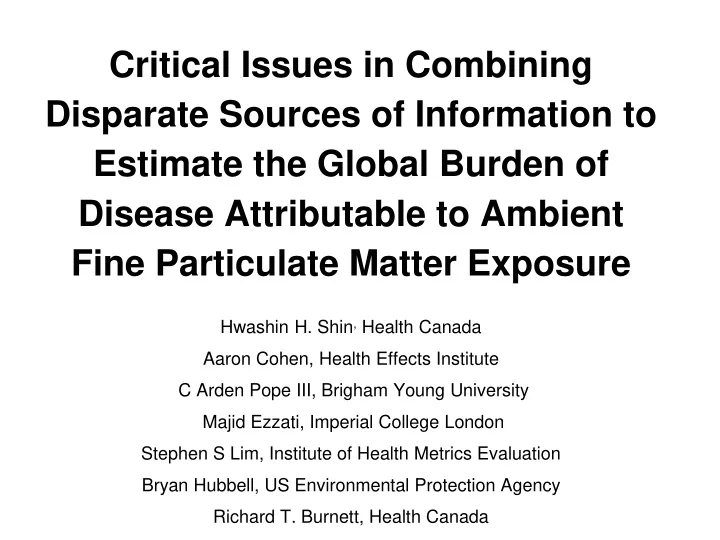

Critical Issues in Combining Disparate Sources of Information to Estimate the Global Burden of Disease Attributable to Ambient Fine Particulate Matter Exposure Hwashin H. Shin , Health Canada Aaron Cohen, Health Effects Institute C Arden Pope III, Brigham Young University Majid Ezzati, Imperial College London Stephen S Lim, Institute of Health Metrics Evaluation Bryan Hubbell, US Environmental Protection Agency Richard T. Burnett, Health Canada
http:/ / www.thelancet.com/ themed/ global-burden-of disease
Distributions of selected regional 2005 3 2005 population-weighted regional estimated estimated PM 2.5 by urban and rural areas average PM 2.5
Needed: a risk model for PM 2.5 exposure over the entire global range
Ischemic Heart Disea Cerebrovascular Str 5 6 5 4 Density Density 4 3 3 2 2 1 1 0 0 1.0 1.5 2.0 2.5 0.8 1.0 1.2 1.4 1.6 1.8 2.0 Hazard Ratio Hazard Ratio Chronic Obstructive Lung Cancer 20 6 5 15 Density Density 4 10 3 2 5 1 0 0 0.8 0.9 1.0 1.1 1.2 1.3 1.4 0.8 1.0 1.2 1.4 1.6 Hazard Ratio Hazard Ratio
Comparison of Ambient Air Pollution Linear (red) and IER (blue) Risk Models for IHD Mortality Old Standard New Standard
Top 15 Global Risk Factors in 2010
Themes • Criteria: – GBD considers an appropriate treatment of “imperfect” data better is than no data • Problem Characteristics – No data on risk at high ambient concentrations – Needed to incorporate ‘indirect” information form disparate combustion sources • Strengths – Something is better than nothing – Estimate risk for sources with no direct information (HAPs and CV mortality) • Limitations – Many (as yet) untested assumptions • Research Needs – Conduct cohort studies in highly polluted environments (Asia)
Recommend
More recommend